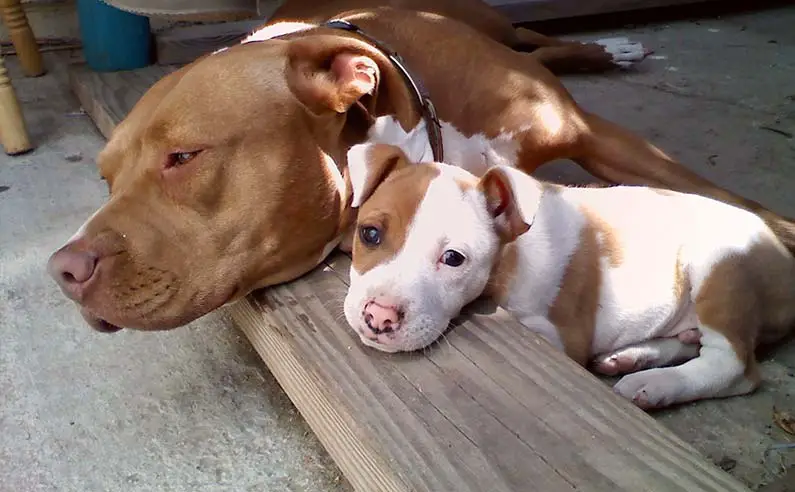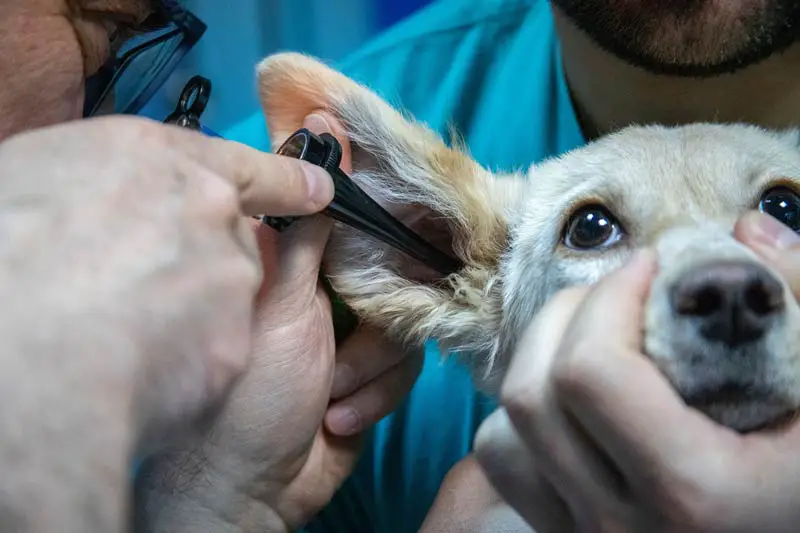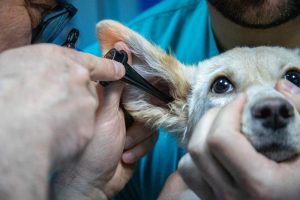
Pitbulls are one of the most adorable breeds to have at home. But, before you raise them to be healthy dogs, they start as puppies that need quality nutrition, good exercise, and proper care. In line with this, you might be wondering: how much do I feed my Pitbull puppy?
In this article, we’ll give you some details, steps, and pointers on how to properly feed your Pitbull with either a homemade or commercial diet that’s just right for their age, weight, health condition, and physical activity.
After all, by having a quality diet plan for your Pitbull puppy, you’ll have less likelihood of worrying about excessive vet bills and puppy allergies in the future. All puppy stages require different amounts of nutrition – and the Pitbull pup is not different from that. Let’s have a look at what you can expect when feeding your Pit puppy.
See also:
Page Contents
How much to feed a Pitbull puppy?
As a general rule, the Pitbull pup is best given 2 cups a day, which should be equally divided into 4 meals. This means that your Pitbull puppy should get a quarter cup for each meal or serving. During their 3-month-old stage, you can increase the amount of food based on his physical activity and weight.
However, the schedule of 4 times a day is only ideal for Pitbull pups that are 12 weeks old and below. After getting past that stage, it’s safe to narrow down the meals to only 3 and then 2 later on when they reach adulthood.
Compared to most breeds, the Pitbull is a breed that digests food quickly, which means they’re bound to eat more than you think they should (and still not gain that much weight). However, when they get older, you should slow down on the calorie intake since they might be at risk of obesity.
Feeding Schedule
For you to know what to expect for a Pitbull puppy when it comes to feeding them properly, here’s a common feeding schedule or guide that will help you out:
Birth to 2 weeks old
During the first and second week, the Pitbull puppy should be reliant on being nursed by their mother. They usually just stay by their mom’s side and by 2 weeks of age, their eyes will be open.
Since Pitbulls naturally have a fast metabolism, and therefore, need a lot of calories, you have to ensure that the mother Pitbull has access to healthy food that will help her give the right amount of milk to her pups.
If you feel that the Pitbull mother doesn’t produce adequate puppy milk, you can talk to your vet for advice. He or she will then give you a suggestion on a milk supplement so that your pups get nursed properly.
Moreover, if one of the Pitbull pups in the litter doesn’t gain sufficient weight (as per our growth chart below), you could also ask that to your vet. They might refer you to a milk replacer formula. This kind of scenario also happens if the Pitbull mother is still too young or if the litter size is just too overwhelming for the mother.
3 to 4 weeks old
When your pup reaches 3 weeks of age, they are still not ready to be weaned because they are still dependent on their mother’s milk. You might hear about some breeders who introduce food slowly by this stage, but it is generally not a good idea.
Instead, the Pitbull pup should be sitting next to their other and getting nursed. However, during this stage, Pitbull puppies are expected to be able to move around to do their business. This means you’ll have to start cleaning up messes in the puppy quarters.
At 4 weeks old, the Pitbull pup learns to walk even better. Despite this, the Pit pup remains dependent on getting nursed. However, during this stage, you can slowly introduce your Pitbull puppy to food. Start by mixing puppy kibble with water with a ratio of 1:3 at first.
Don’t put a lot of food or mixture to avoid getting wasted should your pup ignore it at first. Keep trying – you don’t have to be successful for the first few tries. Always remember that weaning any puppy involves a tremendous amount of patience. That’s why constantly offering the food in their living quarters will help them get used to the sight, smell, and texture.
5 to 6 weeks old
By 5 weeks of age, a Pitbull puppy can still be offered the mixture to train them to get used to solid food. During this week, the pup might become more interested so never give up on trying! Eventually, your pup will like the taste and munch down. However, never try force-feeding because it can cause problematic behaviors in the future.
Even if you are already on your way to making the weaning process smoother, the Pitbull pup should still get its main course from nursing. You shouldn’t put a lot of puppy food into the mixture to avoid wasting it. Your puppy is less likely to finish it all up since they still depend on their mother’s milk at this point.
When the Pitbull pup reaches 6 weeks of age, the food mixture can be adjusted if your puppy begins to like the taste. If you find that your little canine friend starts to munch down on the mixture, reduce the amount of water the next time you prepare it for them. This is what we mean by a gradual process when it comes to weaning.
Again, don’t expect your Pitbull pup to gobble down the food. What’s important is that they are at least tasting a couple of kibble bites. The main calories of a Pitbull pup should still come from the mother’s milk so the puppy food and water mixture is just a supplementary meal at the moment.
7 to 8 weeks old
By 7 weeks of age, your Pitbull pup could already be munching on the food by themselves, learning to like it in the process. When your puppy reaches this milestone, it may be best to completely have them feed dry kibble without the water so that they’ll only eat up the important nutrients.
With that said, a 7-week-old Pitbull puppy could still drink from its mother’s milk, albeit not so much as before. The mother will probably not take a long time nursing the litter since she is also doing her part in getting them ready for independence.
The weaning process will likely end once your Pitbull puppy reaches 8 weeks old. This is the time when your puppy will probably not depend on their mother’s milk anymore. Also, this is the time when scheduled meals should be incorporated into your daily routine to avoid obesity issues.
When it comes to Pitbull puppy feeding, the recommended schedule is 4 times a day – each with equally-divided amounts of food. As with the previous food-water mixture, always remove any untouched food within 20 minutes to avoid spoilage. Not only that – it will train your puppy’s instinct to only chow down within the limited time that they have.
9 to 10 weeks old
A Pitbull puppy can be re-homed from a breeder to a new owner during this time. When your puppy turns 9 weeks old, they will need around 2 cups of food a day with the above-mentioned feeding schedule. If your pup tends to go outside more often, they need more calories to burn, and thus, you can increase their food intake.
With that said, if you got your Pitbull pup from a breeder, make sure to know about the brand of food that they used for weaning the puppy. If you’re intending to use another brand, that’s where a gradual introduction should happen.
When introducing new food to your Pitbull puppy, always remember to do it slowly and gradually. If you give the new food right away, your pup could get digestive upsets, which might add up to your vet bill.
To avoid such inconveniences, prepare a transition period between the old and the new brand. Start with a small amount of the new food mixed with the old food. After a few days, you can transition gradually with the new food being more than the old food, until your puppy eats 100% new food from the bowl.
When your Pitbull pup turns 10 weeks old, they will have this nasty habit of picking up anything they see on the floor, so it’s off-limits to easy-access danger zones around the house. They should only pick up food – not inedible and dangerous objects!
11 to 12 weeks old
A Pitbull puppy at 11 weeks of age can be fed somewhere between 3 and 4 times a day with the right amount (2 cups a day or as needed or advised by the vet). Don’t let their food go bad and take them out within 10 to 20 minutes not only to avoid spoilage but also to train them to only eat within the period.
If your Pitbull pup tends to overeat, proper scheduling will fix such bad habits. By only allowing them to respond to the puppy food within 20 minutes or their food bowl will be taken out, you are teaching discipline in your Pitbull puppy.
By the time your Pitbull pup reaches 12 weeks of age, they are best fed 3 times a day with sufficient calories. That’s because the 12th week is where rapid growth is commonly experienced by Pitbulls.
Although it is tempting to switch the Pitbull puppy to adult food by this time, you’ll still need the calories to keep them at a healthy growth rate. Talk to your vet about the proper time for feeding adult food to your puppy and remember to always take it easy and slow when transitioning them between food types.
Growth Chart
A growth chart will help you figure out how much your puppy should weigh based on their age. While it is not meant to be taken strictly, it can serve as a guideline for your puppy so that they are at an ideal weight that’s not too obese or unhealthy.
You can also use the growth chart to find out if your puppy is underweight or needs additional nutrition. Without further ado, here’s the Pitbull puppy growth chart:
| Age by months | Male | Female |
|---|---|---|
| 1 month | 9.2 lbs | 7.2 lbs |
| 2 months | 19.9 lbs | 16.6 lbs |
| 3 months | 31.3 lbs | 26.7 lbs |
| 4 months | 41.8 lbs | 36.2 lbs |
| 5 months | 50.8 lbs | 44 lbs |
| 6 months | 57.4 lbs | 50.1 lbs |
| 7 months | 62.6 lbs | 54 lbs |
| 8 months | 66.4 lbs | 57.5 lbs |
| 9 months | 69.4 lbs | 59.7 lbs |
| 10 months | 72 lbs | 61.5 lbs |
| 11 months | 74.3 lbs | 63.1 lbs |
| 12 months | 76 lbs | 64.2 lbs |

Recommended Food
Make sure that the food that you should give to your Pitbull puppy contains sufficient nutrients. Here are recommended food options (and nutrients to find in puppy food):
1. Protein
A Pitbull puppy needs about 22% protein and this number lessens as they become adults. Look for reputable protein sources such as chicken, turkey, fish, lamb, and the like. Make sure that the meat source is the first ingredient found in the puppy food – especially if it is dry kibble.
2. Grain-free
As a Pitbull is usually not that tolerant of food allergens, it’s best to feed them with puppy food that doesn’t contain grains. Moreover, excessive grain in your puppy’s food will also cause obesity. Grains such as corn, wheat, soy, and even syrups (glucose and fructose) are often hard to digest for a Pitbull puppy or any dog breed with difficulty digesting such fillers.
3. Glucosamine and chondroitin
These nutrients are found in most puppy foods and dog foods as many breeds have a risk for hip dysplasia – the Pitbull is one of them. By having glucosamine and chondroitin as part of the puppy food (whether in kibble or wet form), you’re ensuring less likelihood of your puppy developing joint diseases and arthritis in the future.
4. Omega fatty acids
Because a Pitbull puppy will be prone to heart problems and skin conditions, they should go on a diet that involves omega fatty acids, which are commonly found on fish and fish oil. Such fatty acids will improve their coat health and respiratory system.
Foods to Avoid
If you want to know which foods should be avoided for your puppy, here are some of them:
- Chocolate. Most pet owners know that chocolate is toxic to pets, but we have to include this in our list as some people, especially kids, are still new to this knowledge.
- Caffeine. Dogs also don’t do well with caffeine in a similar way to chocolate, so you should keep them out of reach from your canine friend.
- Foods with grains. Unfortunately, Pitbulls aren’t so tolerant with grains so they’ll need a different kind of dog food that’s not commonly found in the grocery store. Although such grain-free foods are usually expensive and hard to find, if you want your Pit to stay healthy against allergens then you’ll have to look for such foods. After all, they’re a breed that’s prone to food allergies.
FAQs on Feeding a Pitbull Puppy
So, now that we have information on how much to feed your puppy, what are some considerations with your feeding schedule and food choice? Fortunately, we have some frequently asked questions below:
How do I choose the right food for my Pitbull puppy?
To choose a good puppy food for your needs, you have to know about the following factors, as they decide which pup food is the best for your needs:
1. Your pup’s physical activity
All dog breeds have different physical activity levels. Your pup could be more active than the rest of the litter so they could need more calories to burn. If your pup tends to go outside more, adding balanced amounts of protein and fats is okay.
However, if your pup is usually a homebody and doesn’t have sufficient exercise, they could be at risk for weight issues, health problems, and everything else in between. For such pups, consider dog food that has fewer amounts of fats and protein.
2. Dietary needs as advised by the vet
Some pups develop food allergies and this is where it could get frustrating for the pet owner. To remedy this, talk to your vet about any possible signs of food allergies. After ruling out everything, your vet could give you advice on which dog food brands (or sources of food) are best for your pup.
For example, a puppy that lacks joint health and has a history of arthritis needs glucosamine and chondroitin to make its bones stronger. You will find these in most puppy food nowadays – just read their packaging first to be sure.
3. Little to no fillers
Fillers usually come in the form of corn, soy, and wheat, and have no nutritional value to your dog. While they are okay to consume for humans, dogs have a different digestive system so they will need to get their carb resource from another place.
Look for a puppy food that has healthier carbs instead, such as potatoes, sweet potatoes, peas, and various other veggies. After all, protein and fats are the more important nutrients in any puppy food for healthier growth.
4. No artificial additives or colorants
Unfortunately, many puppy foods out there in the grocery store are filled with artificial flavorings, additives, and colorants, which aren’t exactly healthy for your pup. Instead of compromising your puppy’s health, consider a better option by choosing a different brand.
Many dogs and puppy food brands out there are starting to sell alternatives that are free from excessive additives to help your puppy grow healthier. Even though they are slightly pricier, they will keep the vet bills low in the long run.
5. Quality meat as the first ingredient
Whether it’s chicken, beef, bison, salmon, lamb, turkey, or any other meat, ensure that the puppy food has that kind of meat source as the first or primary ingredient. This ensures that your puppy is getting quality meat and not just random animal parts from unknown sources.
An honest company only wants the best health of your puppy to adulthood so it pays to invest in these companies. They should properly list down the meat ingredients and sources of the puppy food product to inform the pet owners (and the vet).
6. Good packaging
Any puppy or dog food should have good packaging to avoid the food going bad and causing digestive upsets to your pup. Since puppies are still in their early stages of life, they need a lot of nutrients to keep them strong and expired food will mess it up for them.
Should I give my Pitbull puppy treats?
Giving treats to your puppy should be in moderation. It should also be included in your daily calorie count so that your puppy will not be overweight. Many pet owners often forget to regard and include the treats that they give to them during training.
Most treats nowadays that are meant for puppies are flavorful, especially the brands that are in the grocery store. That’s why not all of them are healthy for your pet, so you should choose carefully. Look for puppy treats with sufficient nutrients that will strengthen your puppy’s bones, muscles, immune system, coat health, and everything else in between.

Raw feeding a Pitbull puppy
Raw feeding is a great option or alternative for feeding your Pitbull puppy a balanced diet without the worry of grocery store fillers and additives. However, keep in mind that handling food that hasn’t been cooked yet should be as careful as possible to avoid bacterial contamination.
BARF or biologically appropriate raw foods involve not just raw meat but also a couple of fruits and veggies obtained from a wet market or local grocery store. While most pet enthusiasts say that raw feeding has many benefits, veterinarians, on the other hand, have cautioned for food handling.
When you do want to give your Pitbull pup a BARF diet, always consider the AAFCO nutrient requirements to ensure that their raw diet won’t harm their digestive system. When it comes to feeding raw to your puppy, there are 6 primary nutrients:
1. Protein
This comes from most meat products that are found in the market. Protein is the primary nutrient for your pup because they need it for building muscle and keeping up their energy and strength. Puppies should have 43.8 grams of protein per 1,000 kcal.
2. Fatty acids
This is usually found in certain meats, such as fish, as well as various other grocery meats. Fatty acids may include DHA and EPA and can be around 21.3 to 330 grams per 1,000 kcal.
3. Fat-soluble vitamins
Certain animal organs, such as the liver, have such vitamins. Examples of such vitamins are A, D, K, and E. These vitamins are also found in other sources, such as chicken eggs (vitamin A), salmon and various fish (vitamin D), wheatgrass (vitamin E), and leafy greens (vitamin K).
4. Water-soluble vitamins
These vitamins include B1 for metabolism, B2 for growth and development, B3 for energy, B5 for protein management, and B6 for the nervous system. These are commonly found in both meats and plants. Chicken, pork, and beef organs, as well as salmon and similar fish, are great sources of such vitamins.
5. Macrominerals
These macro minerals include calcium, potassium, magnesium, sodium, and phosphorus. Calcium can be found on raw meaty bones, as well as some veggies like spinach and kale. Fish such as herrings and mackerels provide phosphorus.
Sodium intake for puppies should only be up to 720 mg per 1,000 kcal and is usually found in seafood. Magnesium also helps strengthen bones and is found in greens and seeds. Potassium is found on some greens as well and should make up 1.1 g per 1,000 kcal for a puppy diet.
6. Microminerals
These minerals include iron (blood health), zinc (immune system), copper (red blood cell production), iodine (metabolism), selenium (fat digestion), and manganese (cells). They are found in dog-safe nuts and seeds, as well as most leafy greens like spinach.
Slow-feeding a Pitbull puppy
Since a Pitbull is a deep-chested breed, puppies are at risk to bloat. If you find that your puppy eats too fast, here are easy ways to make them slow down:
- Use a slow-feeder bowl
- Try food puzzles
- Hand-feed your puppy
- Schedule meals strictly
- Use an automatic or scheduled feeder
- Try using a cookie sheet
Conclusion
Feeding your Pitbull puppy with the right amount of food is important so they won’t get into weight issues or digestive upsets. As a breed with great sensitivity towards food allergens common to canines, you should always watch what your Pit is eating.
In the end, it’s still you who gets to decide on puppy food, so make the decision beneficial for your puppy’s overall health. We hope that this guide helped you in feeding your Pitbull pup properly.














